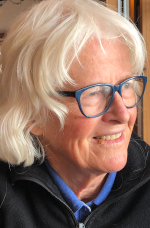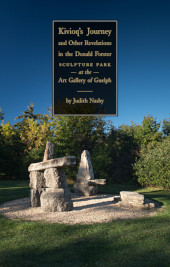The Porcupine's Quill
Celebrating forty years on the Main Street
of Erin Village, Wellington County
BOOKS IN PRINT
Kivioq's Journey and Other Revelations in the Donald Forster Sculpture Park at the Art Gallery of Guelph by Judith Nasby
A photographic tour through the variety of artworks that populate the Art Gallery of Guelph’s storied sculpture garden.
The Donald Forster Sculpture Park is one of the most diverse of its kind in Canada, featuring forty-one outdoor installations by prominent Canadian and international artists on a 2.5-acre site adjacent to the Art Gallery of Guelph.
In Kivioq’s Journey, Judith Nasby takes readers on a pilgrimage through the park—the largest at a public gallery in Canada—to learn about the imposing sculptures, culturally significant monuments, and playful interactive installations that have found a home at the park. She introduces the park’s wide range of contributors, including Canadian settler artists (Walter Bachinski, FASTWÜRMS, Gu Xiong), Indigenous artists (Mary Anne Barkhouse, William Noah, Don Russell), and international artists (Kosso Eloul, Diane Maclean), and she delves into the methods and meanings behind the park’s bronze and stone artworks. Throughout the journey, she reveals not only the sculptures’ relation to each other, but also their harmonious synergy within the landscape and history of this unique and inspiring site.
Excerpt from book
From "History and Concept"
From the beginning, the concept for the sculpture park was to develop a series of outdoor galleries that would feel like an extension of the building. The park is one of the few sculpture gardens in North America with soft landscaping where the objective is not to create a design that requires a pre-determined number of works to complete. The design features a naturalistic approach to landscaping with a perimeter informally defined with trees and shrubs that are native to the area. The outdoor collection would develop as a curatorial project consistent with the gallery’s overall objective to present dynamic exhibitions, conduct research and build a significant collection of contemporary Canadian Art.
As the park is used throughout the year, proposals need to take into account the effect of changing seasons; there could be up to fifty centimeters of snow in winter. On occasion, artists consult with a landscape architect to integrate their ideas with the overall landscape design. The curator works with artists to select the site and finalize the installation. For commissions, the artist proposes an initial idea followed by concept sketches, a maquette and installation specifications.
To begin the transformation of a schoolyard to a sculpture garden landscape architect Walter Kehm created a concept design for fundraising purposes and a construction plan. The gallery completed a successful fundraising campaign with the University of Guelph Chancellor The Hon. Pauline McGibbon, serving as honorary chair. Initial construction began in 1983 when we levelled the central portion of the park and defined the perimeter with berms, evergreens and flowering trees. A white colonnaded court linked the building to the garden. At the same time the gallery commissioned Kosso Eloul to create the first work Passages (1985). This large-scale steel sculpture is on a berm at the leading edge of the park. The selection of the following thirty-nine works evolved in relation to each other. The curatorial strategy is to encourage artists to respond conceptually to the historical and cultural context of the site always with the thought that an exhibition is being created.
The initial process was to hold a national sculpture competition sponsored by Imperial Tobacco Canada Limited (du Maurier Limitée,) in celebration of the twenty-fifth anniversary of their Guelph location. The competition held in 1985 attracted more than 200 submissions resulting in a substantial archive on Canadian sculptors. The competition jury produced a tie between Robert Wiens and Tony Urquhart. Du Maurier Arts Limited generously and conveniently decided to sponsor both sculptures. Their sponsorship continued through 1994 for works by Evan Penny, Catherine Burgess, Brian Scott, and Kim Adams. In 1994, Chair of du Maurier Arts Limited Maureen Forrester ‘unveiled’ Kim Adams’ sculpture Crab-Legs (Studio). She spoke eloquently about the gallery’s initiative to create a nationally important sculpture garden to showcase Canada’s best artists. Later we changed to commissions offered as part of the regular acquisition process. These sculptures are often accompanied by a publication and exhibition.
An objective is to build a collection at the forefront of contemporary Canadian art with an emphasis on regional artists. The Park also aims to provide artists, when possible, with an opportunity to realize their first permanent outdoor public works: Kim Adams, Beth Alber, Jane Buyers, Verne Harrison, Janet Morton, Evan Penny, Gord Peteran, Brian Scott, Cynthia Short, Carl Skelton, Derek Sullivan, Tony Urquhart, Robert Wiens, and Gu Xiong. The park has site-specific pieces by Michael Davey, Susan Detwiler, Kosso Eloul, Rodney Graham, Andrew T. Hunter with William John Hunter, Diane Maclean, Janet Morton, William Noah, Evan Penny, Reinhard Reitzenstein, Don Russell, Brian Scott, Seth, Carl Skelton, Michael Snow, Derek Sullivan, and Tony Urquhart.
With forty works the Donald Forster Sculpture Park is the largest sculpture garden at a Canadian public gallery. The works are discussed in the order of acquisition to reveal the evolution of the curatorial vision for the park. Some commissions arose from our ongoing initiative to engage artists with university scientists to foster new work as a result of their interaction.
Unpublished endorsement
‘[A]n informative, accessible, and essential resource for any art educator, student, or member of the public who is interested in sculpture in Canada. The engaging photographs of the forty-one sculptures in this unique outdoor garden reveal a broad inclusive curatorial objective and illustrate the expressive strengths of diverse aesthetic traditions and cultural models.’
—Ron Shuebrook, former President of OCAD and former Chair, Dept. of Fine Art, University of Guelph
Judith Nasby is curator emerita of the Art Gallery of Guelph. During her career as the gallery’s founding director/curator, she developed the museum’s collection and established the Donald Forster Sculpture Park. Nasby has lectured and toured exhibitions on four continents and is an adjunct professor fine art at the University of Guelph. She is the author of Irene Avaalaaqiaq: Myth and Reality; Rolph Scarlett: Painter, Designer, Jeweller; The Making of a Museum; and is co-author with Craig Pearson of The Cultivated Landscape: An Exploration of Art and Agriculture. She has contributed to several books and exhibition catalogues and to a variety of periodicals, including Canadian Collector, Historic Guelph, and Inuit Art Quarterly. She lives in Guelph, Ontario.
The Porcupine's Quill would like to acknowledge the support of the Ontario Arts Council and the Canada Council for the Arts for our publishing program. The financial support of the Government of Canada through the Canada Book Fund (CBF) is also gratefully acknowledged.





